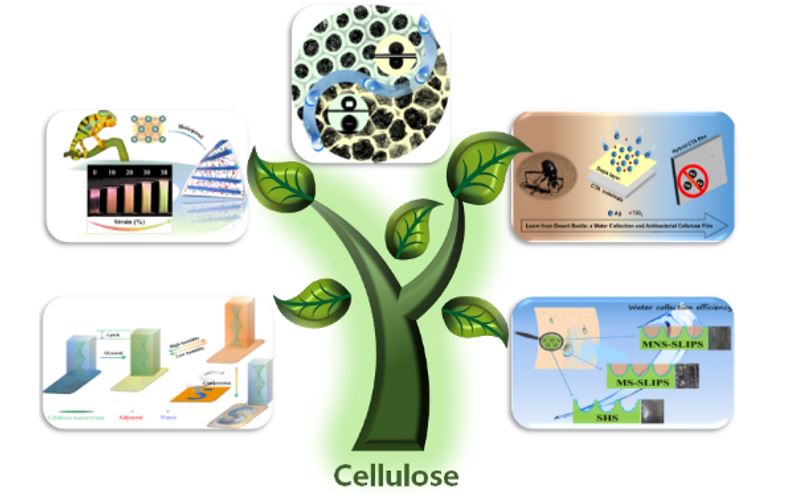Video Article Open Access
Bio-inspired Cellulose-based Materials and their Applications
Fei Song*, Chen Xu, Yao-Dong He, Rui Feng, Ze-Lian Zhang, Xiu Dong, Xiu-Li Wang, Yu-Zhong Wang
The Collaborative Innovation Center for Eco-Friendly and Fire-Safety Polymeric Materials (MoE), National Engineering Laboratory of Eco-Friendly Polymeric Materials (Sichuan), State Key Laboratory of Polymer Materials Engineering, College of Chemistry, Sichuan University, Chengdu 610064, China
Vid. Proc. Adv. Mater., Volume 2, Article ID 2105183 (2021)
DOI: 10.5185/vpoam.2021.05183
Publication Date (Web): 05 Aug 2021
Copyright © IAAM
Graphical Abstract

Abstract
As the oldest and most abundant biomacromolecule on earth, cellulose has been used as one of the earliest materials by humankind. Because of wide resources, renewability, and sustainability, it has been regarded as the one of the best candidates to replace petroleum-derived materials that have caused serious environmental problems, and currently its applications have been extended widely to biomedical, energy, electronic and environmental areas. However, how to mimic natural designs and functions of existing amazing spices/phenomena, developing new functional cellulose materials, still needs to be concerned. Here, we present some examples reported by our group in recent years. To address the global water shortage issue, learning from the fog-harvesting skill of Namib desert beetle, a cellulose-based superhydrophilic/superhydrophobic patterned film, on which nano-TiO2 works as the hydrophilic region to catch water while hydrophobically modified nano-Ag behaves to induce the rolling of water droplets, is constructed. 1043 mg cm−2 h−1 of the water collection efficiency as well as high antibacterial performance is achieved using such film. Considering the long-term application, a nepenthes pitcher plant-inspired slippery liquid-infused porous surface with high stability is developed through synergistical construction of regular micro-pincushion and nanoparticles on a cellulose film. Such film can collect water continuously and stably from air. On the other hand, to biomimic structural colors in nature as well as color changes responsive to environmental stimuli, a highly flexible, controllably iridescent, and multistimuli-responsive cellulose nanocrystal (CNC) film is prepared through the co-assembly with glycerol, a small molecule acting as plasticizer and hygroscopic agent. The presence of glycerol results in the enhanced mechanical toughness, making it possible to prepare free-standing iridescent CNC films with tunable structural colors. Upon exposure to different environmental humidity and mechanical compression, such films can change colors in terms of self-adjusted chiral nematic structures. Furthermore, inspired by the elastic skin of chameleons, a polymeric network is constructed in the assembled CNC structure, fabricating free-standing and flexible structural-color films with a fracture strain of 39%. Notably, the CNC film shows reversible structural-color change upon stretching. The elastic film also displays humidity- and compression-triggered color changes that enable potential encryption and anticounterfeiting applications.
Keywords
Cellulose; bio-inspired; water -collection; structural color.
Acknowledgement
This work was supported by the National Natural Science Foundation of China (grant 51773133 and 52073189), the Science and Technology Fund for Distinguish Young Scholars of Sichuan Province (2019JDJQ0025), the State Key Laboratory of Polymer Materials Engineering (sklpme2020-3-09), and 111 project (B20001).
References
- C. Xu, R. Feng, F. Song, X. L. Wang, Y. Z. Wang, ACS Sustainable Chemistry & Engineering, 2018, 6, 14679.
- C. Xu, R. Feng, F. Song, J. M. Wu, Y. Q. Luo, X. L. Wang, Yu-Zhong Wang, Chemical Engineering Journal,2018,352, 722.
- R. Feng, C. Xu, F. Song, X. L. Wang, Y. Z. Wang, ACS Applied Materials & Interface, 2020, 12, 12373.
- Z. L. Zhang, X. Dong, Y. N. Fan, L. M. Yang, L. He, F. Song, X. L. Wang, Y. Z. Wang, ACS Applied Materials & Interfaces, 2020, 12, 46710. 18.
- Y. D. He, Z. L. Zhang, J. Xue, X. H. Wang, F. Song, X. L. Wang, L. L. Zhu, Y. Z. Wang, ACS Applied Materials & Interfaces, 2018, 10, 5805.
Biography
Fei Song obtained his Bachelor and PhD degrees in 2004 and 2009 from Sun yat-sen University. Then he moved to Hongkong Polytechnic University, working as a Postdoc Fellow. From 2010, he joined Sichuan University as a Lecture, and then was promoted to Associate Professor and Full Professor in 2012 and 2017, respectively. He dedicates to develop new sustainable polymeric materials from biomass resources, mainly including: nano-functionalization of polysaccharides, surface and interface of natural polymer materials, bio-inspired materials, and bio-based and biodegradable (co-)polymers. He has accomplished over 10 projects financially supported by governments and companies, authored and co-authored over 70 peer reviewed SCI journal publications, 1 invited book, 1 invited book chapter, and held 4 issued patents. His research has been highlighted by ACS News Service Weekly PressPac, AAAS EurekAlert, IOM3, Phys Org, IOP Nanotechweb, etc. He has presented over 20 invited/oral talks at international conferences and now serves as an editorial board member of some journals.
Video Proceedings of Advanced Materials

Upcoming Congress



